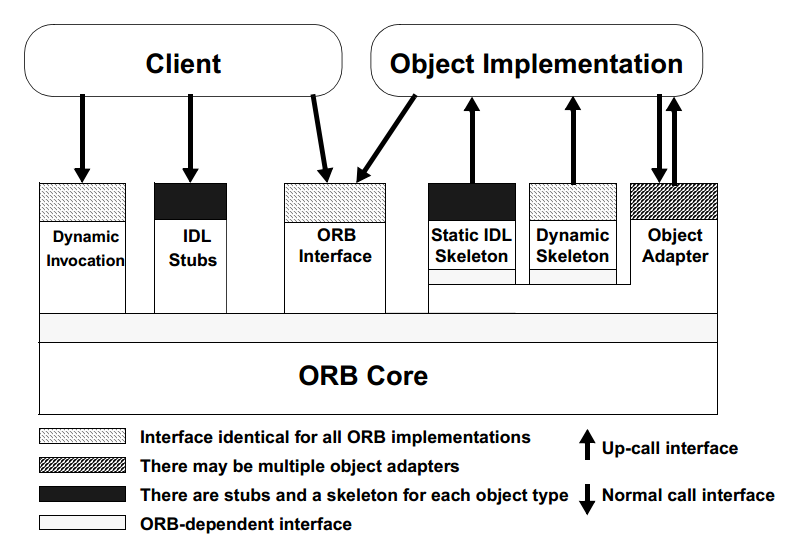- CORBA基本架构
- IDL文件编写
- CPP示例实现(上)
- CPP示例实现(下)
- C示例实现(IOR+NS上)
- C示例实现(IOR+NS下)
- C示例实现(IOR上)
- C示例实现(IOR下)
在linux系统下,有很多开源的CORBA通讯框架,在CPP的示例中,使用了OmniORB的框架。
如我用的是Debian系统,可以直接安装:
apt-get install omniorb apt-get install omniorb-nameserver apt-get install omniidl apt-get install libomniorb4-dev export OMNIORB_CONFIG=/etc/omniORB.cfg
然后修改配置文件/etc/omniORB.cfg,修改日志输出级别。
编译Hi.idl文件,将生成文件Hi.hh及HiSK.cc
omniidl -bcxx Hi.idl
首先完成服务端部分,分了三个文件:
HiServerImpl.hh
#include <CORBA.h>
#include "Hi.hh"
class HiServerImpl : public virtual POA_HiCorba::Hi, public virtual PortableServer::RefCountServantBase
{
public:
HiServerImpl();
~HiServerImpl();
char* sayHiTo(const char* someone);
::CORBA::Long add(::CORBA::Long numa, ::CORBA::Long numb);
void shutdown();
};
HiServerImpl.cc
#include <vector>
#include <string>
#include <string.h>
#include <sys/types.h>
#include <unistd.h>
#include <stdio.h>
#include <stdlib.h>
#include <iostream>
#include <fstream>
#include <stdio.h>
#include <sys/wait.h>
#include "HiServerImpl.hh"
using namespace HiCorba;
HiServerImpl::HiServerImpl()
{
}
HiServerImpl::~HiServerImpl()
{
}
char* HiServerImpl::sayHiTo(const char* someone)
{
}
::CORBA::Long HiServerImpl::add(::CORBA::Long numa, ::CORBA::Long numb)
{
return numa+numb;
}
void HiServerImpl::shutdown()
{
}
HiServer.cc
#include <stdlib.h>
#include <iostream>
#include <string>
#include <assert.h>
#include <signal.h>
#include <unistd.h>
#include "HiServerImpl.hh"
#include "Hi.hh"
using namespace std;
int main(int argc, char** argv)
{
try {
//------------------------------------------------------------------------
// Initialize CORBA ORB - "orb"
//------------------------------------------------------------------------
CORBA::ORB_var orb = CORBA::ORB_init(argc, argv);
//------------------------------------------------------------------------
// Servant must register with POA in order to be made available for client
// Get reference to the RootPOA.
//------------------------------------------------------------------------
CORBA::Object_var obj = orb->resolve_initial_references("RootPOA");
PortableServer::POA_var _poa = PortableServer::POA::_narrow(obj.in());
//------------------------------------------------------------------------
// Operations defined in object interface invoked via an object reference.
// Instance of CRequestSocketStream_i servant is initialized.
//------------------------------------------------------------------------
HiServerImpl* impl = new HiServerImpl();
//------------------------------------------------------------------------
// Servant object activated in RootPOA.
// (Object id used for various POA operations.)
//------------------------------------------------------------------------
PortableServer::ObjectId_var myOid = _poa->activate_object(impl);
//------------------------------------------------------------------------
// Obtain object reference from servant and register in naming service(??)
//------------------------------------------------------------------------
CORBA::Object_var SA_obj = impl->_this();
//------------------------------------------------------------------------
// Obtain a reference to the object, and print it out as string IOR.
//------------------------------------------------------------------------
CORBA::String_var sior(orb->object_to_string(SA_obj.in()));
cerr << "'" << (char*)sior << "'" << endl;
//========================================================================
// Bind (rebind) object (orb) to name (SA_obj)
//========================================================================
//------------------------------------------------------------------------
// Bind object to name service as defined by directive InitRef
// and identifier "OmniNameService" in config file omniORB.cfg.
//------------------------------------------------------------------------
//CORBA::Object_var obj1=orb->resolve_initial_references("OmniNameService");
CORBA::Object_var obj1=orb->resolve_initial_references("NameService");
assert(!CORBA::is_nil(obj1.in()));
cerr << "resolve_initial_references successed" << endl;
//------------------------------------------------------------------------
// narrow this to the naming context
//------------------------------------------------------------------------
CosNaming::NamingContext_var nc = CosNaming::NamingContext::_narrow(obj1.in());
assert(!CORBA::is_nil(nc.in()));
cerr << "narrow successed" << endl;
//------------------------------------------------------------------------
// Bind to CORBA name service. Same name to be requested by client.
//------------------------------------------------------------------------
CosNaming::Name name;
name.length(1);
name[0].id=CORBA::string_dup("Hi");
nc->rebind (name,SA_obj.in());
cerr << "rebind successed" << endl;
//========================================================================
impl->_remove_ref();
//------------------------------------------------------------------------
// Activate the POA manager
//------------------------------------------------------------------------
PortableServer::POAManager_var pmgr = _poa->the_POAManager();
pmgr->activate();
cerr << "poamanager activate successed" << endl;
//------------------------------------------------------------------------
// Accept requests from clients
//------------------------------------------------------------------------
orb->run();
//------------------------------------------------------------------------
// If orb leaves event handling loop.
// - currently configured never to time out (??)
//------------------------------------------------------------------------
orb->destroy();
free(name[0].id); // str_dup does a malloc internally
}
catch(CORBA::SystemException&) {
cerr << "Caught CORBA::SystemException." << endl;
}
catch(CORBA::Exception&) {
cerr << "Caught CORBA::Exception." << endl;
}
catch(omniORB::fatalException& fe) {
cerr << "Caught omniORB::fatalException:" << endl;
cerr << " file: " << fe.file() << endl;
cerr << " line: " << fe.line() << endl;
cerr << " mesg: " << fe.errmsg() << endl;
}
catch(...) {
cerr << "Caught unknown exception." << endl;
}
return 0;
}
MakeServer
CC = /usr/bin/g++
CPPFLAGS = -g -c -I/usr/include -I/usr/include/omniORB4
LDFLAGS = -g -L/usr/lib -lomniORB4 -lomnithread -lomniDynamic4
OMNIIDL = /usr/bin/omniidl
all: HiServer.bin
HiServer.bin: HiSK.o HiServerImpl.o HiServer.o
$(CC) $(LDFLAGS) -o HiServer.bin HiSK.o HiServerImpl.o HiServer.o
HiSK.o: HiSK.cc Hi.hh
$(CC) $(CPPFLAGS) $(INCLUDES) HiSK.cc
HiServer.o: HiServer.cc Hi.hh
$(CC) $(CPPFLAGS) $(INCLUDES) HiServer.cc
HiServerImpl_i.o: HiServerImpl.cc HiServerImpl.hh Hi.hh
$(CC) $(CPPFLAGS) $(INCLUDES) HiServerImpl.cc
nidl: Hi.idl
$(OMNIIDL) -bcxx Hi.idl
clean:
rm -f *.o
rm -f *.bin
编译
make -f MakeServer

